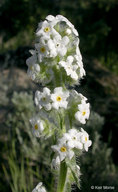Taxon Details
Oreocarya glomerata
cocks-comb cat's-eye
View Report Copy Link Calflora eFlora CCH CalPhotos iNaturalist
Taxon Summary:
Oreocarya glomerata, commonly known as cocks-comb cat's-eye, is a perennial herb in the Boraginaceae that is found in California and elsewhere. It occurs within Pinyon and juniper woodland, growing at elevations from 1555 to 2160 meters. Oreocarya glomerata is ranked 2B.3, Plants Rare, Threatened, or Endangered in California, But More Common Elsewhere; Not very threatened in California.|
Scientific Name: Oreocarya glomerata (Pursh) Greene |
||
|
Common Name: cocks-comb cat's-eye |
||
| Family: | Boraginaceae | |
| Element Code: | PDBOR0A0F0 | |
| USDA Plants Symbol: | CRCE | |
|
Synonyms/Other Names: |
||
| Name Status: |
JEF, FNA, POWO, IPNI, Tropicos |
|
| CA Rare Plant Rank: | 2B.3 |
| Fed List: | None |
| State List: | None |
| Global Rank: | G5 |
|
State Rank: |
S1 |
| Other Status: | |
|
CRPR Changes: added to 2.3 on 2009-08-03 |
|
| Add Date: | 2009-08-03 |
| Date Edited: | 2025-10-29 |
| Lifeform: perennial herb | ||||||||||||||
Blooming Period: Jul-Aug
|
||||||||||||||
|
Elevation:
1555 - 2160 meters 5100 - 7085 feet |
||||||||||||||
General Habitats:
|
||||||||||||||
| Microhabitat Details: | ||||||||||||||
|
Microhabitat:
|
||||||||||||||
| Threat List Total: | 3 | |
| Total EOs | % of EOs | |
| EOs with Threat Listed: | 2 | 25 % |
| THREAT LIST: | ||
|---|---|---|
| Erosion/runoff | 1 | 12% |
| Foot traffic/trampling | 1 | 12% |
| Recreational use (non-ORV) | 1 | 12% |
| Total Occurrences: | 8 | ||||
| Element Occurrence Ranks: | |||||
|---|---|---|---|---|---|
| A | B | C | D | X | U |
| 0 | 1 | 1 | 0 | 0 | 6 |
| Occurrence Status: | |||||
|---|---|---|---|---|---|
| Historical >20 Years | 5 | ||||
| Recent <=20 Years | 3 | ||||
| Presence: | |||||
|---|---|---|---|---|---|
| Presumed Extant | 8 | ||||
| Possibly Extirpated | 0 | ||||
| Presumed Extirpated | 0 | ||||
| California Endemic: | |||||||||||||
| California Island: | |||||||||||||
|
States: Name (Code) California (CA), Idaho (ID), Nevada (NV), Oregon (OR), Washington (WA) |
|||||||||||||
|
California Counties and Islands: Name (Code) Modoc (MOD), Siskiyou (SIS) |
|||||||||||||
|
Quads: Name (Quad Code) Caldwell Butte (4112164), Canby (4112047), Cedarville (4112052), Eagle Peak (4112032), Eagleville (4112031), Warren Peak (4112042), Washington Mtn. (4112048) |
|||||||||||||
Notes:
|
|||||||||||||
 Presumed Extant
Presumed Extant
Click on quad for name. Hold Shift Key to use mouse scroll wheel


